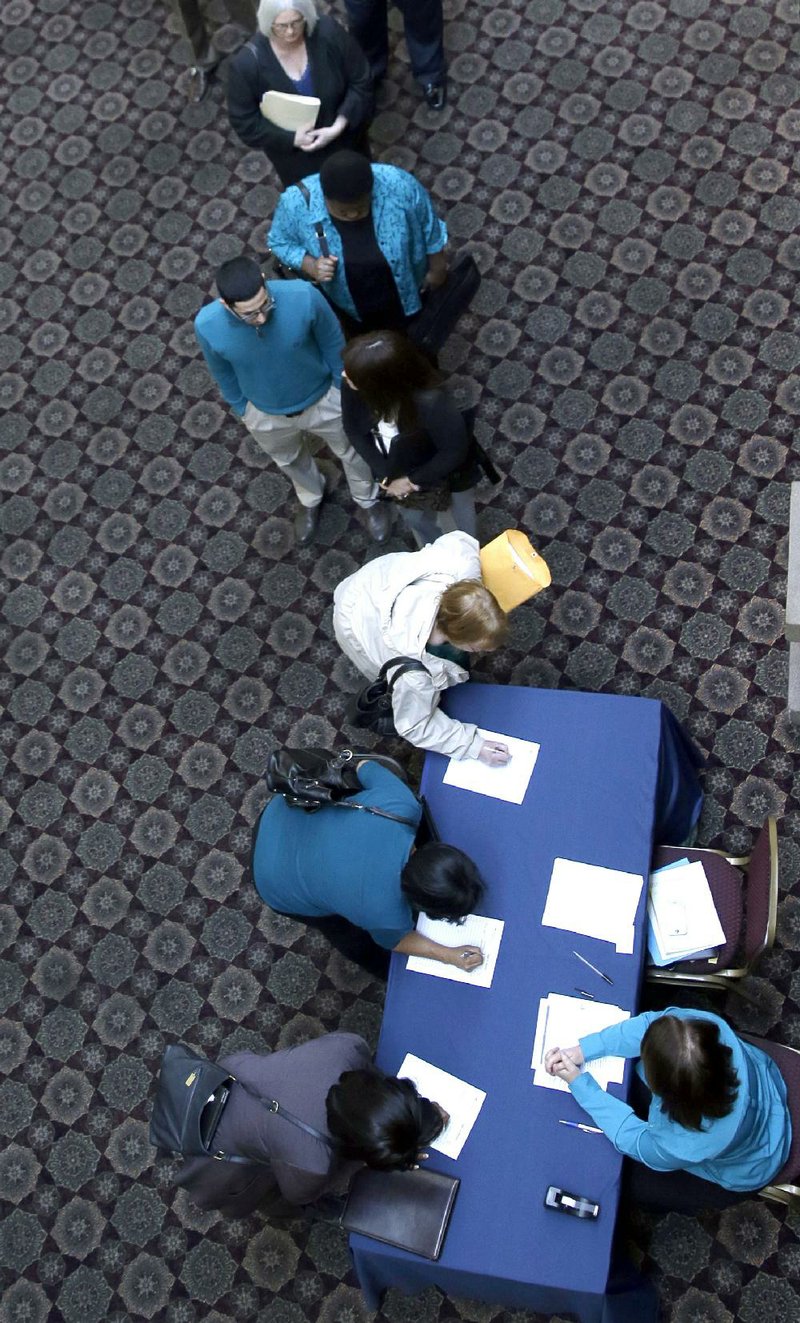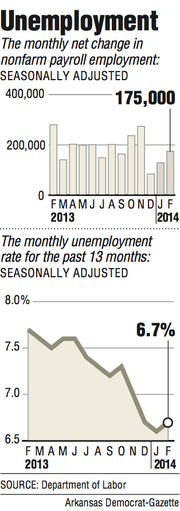WASHINGTON - Brutal winter weather snarled traffic, canceled flights and cut power to homes and factories in February. Yet it didn’t faze U.S. employers, who added 175,000 jobs, the Labor Department reported Friday.
RELATED ARTICLE
http://www.arkansas…">Consumer credit up by $13.7 billion
Modest but steady job growth has become a hallmark of a nearly 5-year-old economic rebound that remains sluggish yet resilient. The economy has been slowed by political gridlock, harsh weather and global crises. Those disruptions have hampered growth but haven’t derailed it.
“It’s a pretty good report, given the weather,” said Stuart Hoffman, chief economist at PNC Financial Services Group Inc. in Pittsburgh. “You had a pretty good rise in average hourly earnings, you had some good gains in jobs in a couple of different sectors.”
Though the unemployment rate rose to 6.7 percent from a five-year low of 6.6 percent, it did so for an encouraging reason: More people grew optimistic about their job prospects and began seeking work.The unemployment rate rose because some didn’t immediately find jobs.
Friday’s report suggested that a long-hoped-for acceleration in growth and hiring still hasn’t occurred. But that might not be all bad: Households have pared debt and have avoided the excessive spending and borrowing that have undercut explosive economies in the past. And moderate but consistent hiring still means more people have money to spend.
The payroll gain in February was well short of the pace needed to return the economy to full employment in the next few years. But it was twice the number added in December, when the cold and snow arrived.
“It’s a normalization,” said Julia Coronado, chief economist for North America at BNP Paribas. “It’s not clear just how much effect the weather had, but it seems like we’re on a moderate but steady hiring trend.”
Some economists suggested that having endured harsh weather, the economy may be poised to pick up in coming months.
“If not for poor weather conditions, job growth would have been stronger,” said Michelle Meyer, an economist at Bank of America Merrill Lynch. “This suggests we should see solid gains … in coming months.”
The figures were a welcome surprise after recent economic data showed that severe weather had closed factories, lowered auto sales and slowed home purchases.Along with a sharp increase in wages last month, the jobs report indicates that some employers are confident that consumer spending will pick up in coming months.
The weather appeared to have less effect on hiring than most economists had feared. Construction companies, which usually stop work in bad weather, added 15,000 jobs. Manufacturing gained 6,000 for a second-straight month. Government added 13,000 jobs, the most in six months.
Daniel Alpert, managing partner at Westwood Capital, noted that roughly two thirds of the job growth in January and February was in higher-paying industries. That’s a reversal from all of last year, when about two thirds of job growth was in lower-paying fields.
A category called professional and business services, which includes better-paying jobs such as engineers, accountants and architects, along with some lower-paying jobs such as temporary workers, added 79,000 jobs in February. That was the most in a year.
Retailers, though, lost 4,100 jobs, transportation and warehousing firms 3,600.
Despite February’s solid overall gain, the monthly average of 129,000 jobs that employers have added from December through February marks the weakest three-month stretch since mid-2012. It’s down from a 225,000 average for the previous three months.
The government revised up its estimate of job gains for December and January by a combined 25,000. December’s gain was revised up from 75,000 to 84,000, January’s from 113,000 to 129,000.
Friday’s report makes it likely that the Federal Reserve will continue reducing its monthly bond purchases at its next meeting March 18-19. The Fed is buying Treasury and mortgage bonds to try to keep long-term loan rates low to spur growth. Fed policymakers have reduced their monthly bond purchases by $10 billion at each of their past two meetings to $65 billion.
Fed officials have de-emphasized the unemployment rate as a point at which it would consider raising borrowing costs.
Labor-market improvement is one reason why policymakers have dialed back monthly bond buying.
While Fed Chairman Janet Yellen reiterated the6.5 percent threshold in testimony before the Senate Banking Committee Feb. 27, the Federal Open Market Committee debated “the reliability of the unemployment rate as an indicator of overall labor-market conditions,” minutes of Fed officials’ last meeting showed.
Average hourly pay rose 9 cents in February to $24.31, the biggest gain since June. Hourly wages have risen 2.2 percent over the past 12 months, ahead of 1.6 percent inflation over that time. That could mean that employers are finally starting to increase pay after several years of stagnant wages.
Economists cautioned that further sustained increases would be needed to signify a broad pickup in pay. Some of the wage increase likely reflects the recent job gains in higher-paying fields.
Though harsh winter weather didn’t appear to slow hiring much, more than 6 million Americans said weather forced them to work part time in February rather than full time. That was the highest such level for any February in the 36 years that the government has tracked the figure.
Those wo rke rs we re counted as employed and didn’t distort either the February job gain or unemployment rate. But for many, fewer hours will mean lower pay. That might be holding back consumer spending and the economy in the current January-March quarter.
Some recent reports hint that the economy will accelerate as the weather warms.The number of people who applied for unemployment benefits fell last week and is at about the same level as before the recession.
Applications for unemployment benefits essentially reflect layoffs. The decline suggests that companies are confident about growth, because layoffs would rise if employers expected business to weaken. Instead, companies advertised more jobs online last month, according to the Conference Board.
Still, other factors are weighing on the economy. Automakers and other manufacturers built up big stockpiles of goods in the second half of last year. That means they are likely producing fewer goods this year and is probably one reason factory orders are down.
Most economists forecast the economy will grow at a 2 percent annual pace or less in the first three months of the year, down from a 2.4 percent pace in the final three months of 2013. But they expect growth to accelerate in the spring and summer to roughly a 3 percent annual pace.
“We continue to believe the economy will defrost in the spring and heat up in the summer,” said Meyer of Bank of America Merrill Lynch.
Information for this article was contributed by Christopher S. Rugaber, Josh Boak and Paul Wiseman of The Associated Press; by Jeanna Smialek and Chris Middleton of Bloomberg News; and by Nelson D. Schwartz of The New York Times.
Front Section, Pages 1 on 03/08/2014


